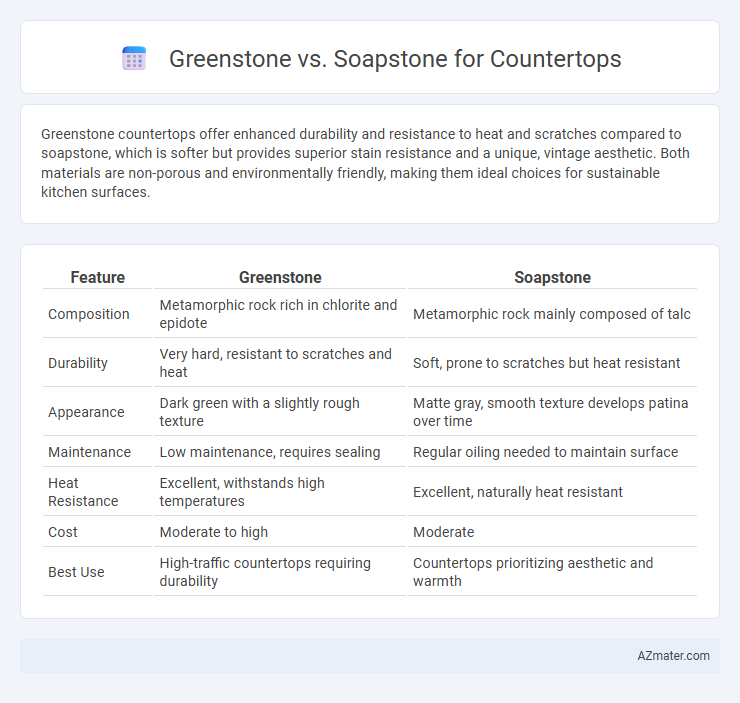Greenstone countertops offer enhanced durability and resistance to heat and scratches compared to soapstone, which is softer but provides superior stain resistance and a unique, vintage aesthetic. Both materials are non-porous and environmentally friendly, making them ideal choices for sustainable kitchen surfaces.
Table of Comparison
| Feature | Greenstone | Soapstone |
|---|---|---|
| Composition | Metamorphic rock rich in chlorite and epidote | Metamorphic rock mainly composed of talc |
| Durability | Very hard, resistant to scratches and heat | Soft, prone to scratches but heat resistant |
| Appearance | Dark green with a slightly rough texture | Matte gray, smooth texture develops patina over time |
| Maintenance | Low maintenance, requires sealing | Regular oiling needed to maintain surface |
| Heat Resistance | Excellent, withstands high temperatures | Excellent, naturally heat resistant |
| Cost | Moderate to high | Moderate |
| Best Use | High-traffic countertops requiring durability | Countertops prioritizing aesthetic and warmth |
Introduction to Greenstone and Soapstone Countertops
Greenstone countertops, composed primarily of metamorphic stone with a unique blend of minerals, offer high durability and a distinctive greenish hue that enhances kitchen aesthetics. Soapstone countertops, crafted from a dense, talc-rich rock, provide exceptional resistance to heat and stains, developing a smooth, dark patina over time that adds character to any space. Both materials deliver longevity and natural beauty, making them popular choices for eco-conscious kitchen designs.
Origin and Composition of Greenstone
Greenstone, predominantly sourced from metamorphic rocks originally formed in regions such as Vermont and parts of China, offers a durable alternative for countertops, characterized by a dense, fine-grained composition rich in minerals like chlorite and epidote. Unlike soapstone, which mainly consists of talc providing a softer texture, greenstone's unique mineralogical makeup contributes to its enhanced hardness and resistance to stains and heat. This mineral composition of greenstone allows it to maintain a rich, earthy green color that deepens with age, making it both functional and aesthetically appealing for kitchen surfaces.
Unique Properties of Soapstone
Soapstone countertops feature a unique composition rich in talc, making them exceptionally soft, heat-resistant, and stain-resistant compared to other natural stones like greenstone. Their non-porous surface naturally inhibits bacteria and does not require sealing, providing hygienic and low-maintenance benefits. Soapstone also develops a distinctive patina over time, enhancing its aesthetic appeal with rich, warm tones that deepen with age.
Aesthetic Appeal: Color and Texture Comparison
Greenstone countertops showcase a rich palette of deep greens with subtle flecks of lighter hues, offering a natural, earthy aesthetic that enhances rustic and contemporary kitchens. Soapstone features a softer, matte finish with shades ranging from pale gray to deep charcoal, often marked by delicate veining that provides a smooth, elegant appearance. The textured complexity of greenstone contrasts with the smooth, uniform surface of soapstone, allowing homeowners to choose between bold color variation and understated classic beauty.
Durability and Resistance to Wear
Greenstone countertops exhibit exceptional durability due to their dense, tightly packed mineral composition, making them highly resistant to scratches and chips. Soapstone, while softer and more prone to dents, offers excellent resistance to heat and chemical stains, maintaining its integrity over time with proper care. Both materials provide durable surfaces, but greenstone's superior hardness ensures better wear resistance in high-traffic kitchen environments.
Maintenance Requirements for Each Material
Greenstone countertops require minimal maintenance due to their natural hardness and resistance to scratches and stains, needing only periodic sealing to preserve their appearance. Soapstone countertops demand more frequent oiling to maintain their rich color and prevent moisture absorption, although they are highly resistant to heat and stains. Both materials benefit from gentle cleaning with non-abrasive cleaners and avoid harsh chemicals to extend their durability and aesthetic appeal.
Environmental Impact and Sustainability
Greenstone countertops offer superior environmental benefits due to their abundant availability and low-impact quarrying process, which minimizes habitat disruption. Soapstone is also eco-friendly, featuring natural non-toxicity and durability that extends its lifespan, reducing waste over time. Both materials provide sustainable options, but greenstone's lighter quarry footprint and recyclability often make it a preferred choice for environmentally conscious kitchen designs.
Cost Comparison: Greenstone vs Soapstone
Greenstone countertops typically cost between $70 to $120 per square foot, making them a more affordable option compared to soapstone, which ranges from $75 to $150 per square foot. Installation expenses for both materials are similar, generally falling between $30 and $50 per square foot, but soapstone's higher material price significantly impacts the overall budget. Homeowners seeking durable countertops with a balance of cost and aesthetics often find greenstone offers better value compared to the premium pricing of soapstone.
Ideal Applications in Home Design
Greenstone countertops, known for their exceptional durability and rich, dark hues, are ideal for high-traffic kitchen islands and contemporary bathroom vanities that demand both style and resilience. Soapstone offers a softer, matte finish with excellent heat resistance, making it perfect for rustic kitchens, laboratory-style countertops, and artisanal home designs where smooth maintenance and natural aging add character. Both materials excel in applications requiring longevity and visual appeal, with greenstone suited for sleek modern aesthetics and soapstone favored in cozy, traditional environments.
Pros and Cons: Which Countertop Is Right for You?
Greenstone countertops offer exceptional durability and natural resistance to heat and scratches, making them a practical choice for busy kitchens, while their unique dark green hues provide a sophisticated aesthetic. Soapstone countertops are prized for their silky smooth texture and excellent stain resistance, but they are softer and can develop a charming patina over time, requiring periodic maintenance. Choosing between Greenstone and Soapstone depends on your preference for low-maintenance hardness versus a softer, more vintage look that evolves with use.

Infographic: Greenstone vs Soapstone for Countertop
 azmater.com
azmater.com